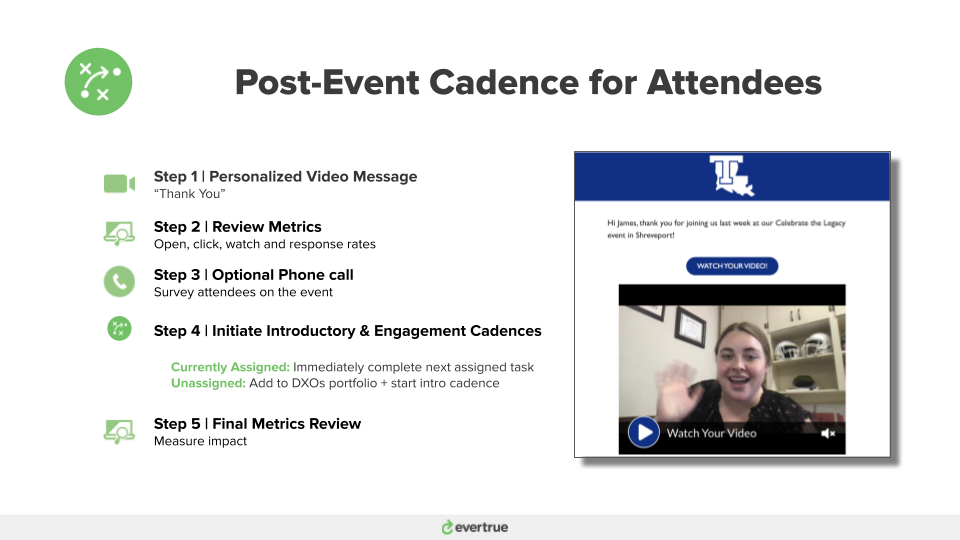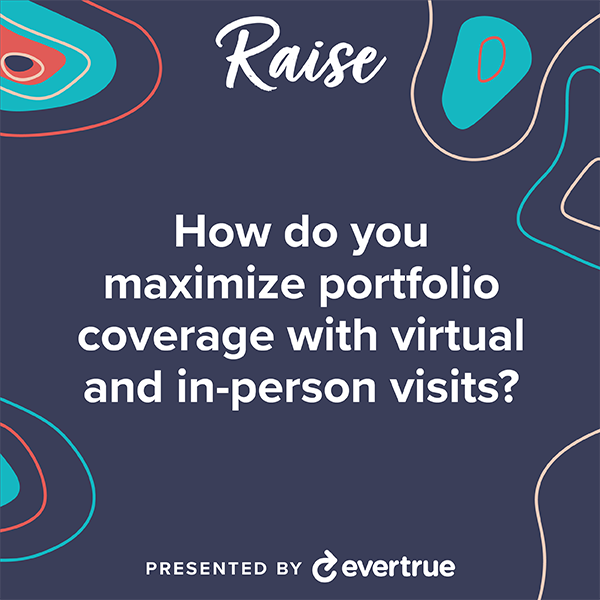We recently sat down with Brooks Hull from the Louisiana Tech University Foundation and Ray Earl-Jackson from Northern Illinois University to discuss how they work towards achieving full portfolio coverage, and what we should all be striving for in our philanthropic work.
A theme that came up multiple times? Fundraising is an art. So…how should we be painting the future of fundraising? And how can we continue to perfect the craft?
Then read on for our top takeaways.
Start with a blank canvas: Build your team and define what metrics you’re tracking.
Okay, so maybe it’s next to impossible to start with a truly blank canvas. But, it’s a good exercise to think about what you’d implement if you could.
Both Brooks and Ray agree that having an in-depth, holistic onboarding process is one of the first things a gift officer needs to be set up for success. Historically, when a gift officer began a new position, they’d be given a list of people to start engaging with right off the bat, with little training outside of that. But, there are so many things we can equip gift officers with now to set them up for success from day one!
(We made this checklist to guide gift officer onboarding. Check it out.)
Some crucial keys to creating a successful onboarding program:
- Taking a page from Brooks Hull’s book, consider your team of gift officers to be more like “philanthropic advisors”. They are representatives of the university, and will be guiding donors to ultimately invest in the institution. Make sure they are equipped with the right information and approach.
- Set intentional expectations. What are you expecting them to do? What are metrics that go along with those expectations? What is the culture of the organization? What is at the core of why you do what you do? Make sure that’s communicated right at the start.
- Have constant immersion in these expectations beyond just the first two weeks…continue to provide that context and support along the way.
Hand in hand with setting these expectations comes clearly communicating the metrics you are tracking.
2020 changed a lot for a lot of institutions. Most had never been in a position to reach the number of people “on the ground” as is possible now through qualification and cultivation work on Zoom. So, what does the shift in outreach methods mean for how we define “quality contacts”? Pre-COVID, “donor visits” were defined as in-person, sitting-across-the-table and having a conversation. Now, it’s less focused on WHERE the conversation takes place, and instead the quality and the result of the conversation. Hopping on Zoom with someone can be just as beneficial to move the relationship as meeting with them in person (and sometimes more, given the convenience of virtual visits).
Here are a few ideas of questions to determine if something counts as a quality contact:
- What was the outcome of the conversation?
- Was I able to move the relationship to the next stage of cultivation as a result of this conversation?
- Do I understand more about this person now, and will this new information help me create a written proposal for this person?
Aside from quality contacts, some other metrics to track include:
- How many proposals have been submitted?
- What is the total number of dollars raised?
- How many qualification visits?
- What’s the overall growth of our pipeline?
- How many constituents are under management?
- How many 1:1 actions were taken?
- Have you identified planned giving prospects?
- Who are the planned giving prospects in the portfolios across the team?
- How is that team supporting the movement of those planned gift solicitations?
This last point helps with accountability for the entire team, and aids in predictability for where things are headed. NIU has started tracking success in unrestricted gifts and paying more attention to what they call the “Triple ask”: Restricted gift, unrestricted gift, and a planned gift. They’re serious about this, too, by investing both time and money into ensuring the team is well equipped in this area.
The goal of the Triple Ask at NIUl? To aid in the future retention of their donor base overall, especially in the mid-level giving range.
Practice makes perfect.
Like most humans, gift officers thrive on structure. At the core, the process behind closing a gift goes like this: Go on visits. Ask for gifts. Follow up on those visits. Close gifts. Repeat.
But of course, there are so many outside factors that can complicate the process. Having a true north star to come back to helps diminish the ambiguity that sometimes comes along with relationship management. Two ways this can be accomplished: Regular check-ins and cadence-based outreach.
At EverTrue, we’re firm believers in the power of cadenced outreach…it’s a core part of our Donor Experience partnerships, and we equip our Donor Experience Officers with tried-and-true outreach structures to engage every donor on their caseload.
Cadenced outreach can be applied outside of a Donor Experience program, too. Institutions are more equipped today than ever before to provide a roadmap to gift officers to help close a gift. So, while both Brooks and Ray agree that 3-4 quality contacts are needed before a major gift ask, they also recognize that more touch points may be needed to fully engage a donor.
(We have learned from our Donor Experience partners that it takes an average of 6.6 touchpoints to book a meeting with previously unresponsive donors. Polite persistence is key.)
Brooks and Ray focus on guiding their team six months at a time. Within those six months, they expect gift officers to make 6-7 contacts with a constituent. They’ve found this frequency of outreach to be successful, as typically around the sixth or seventh contact, the donor responds that they’re interested in having a conversation.
Another idea for creative cadenced outreach? Post-event outreach to attendees. Take a look at how Donor Experience Officers at LA Tech converted “Celebrate the Legacy” event registrants into managed prospects.

Both LA Tech and NIU have implemented quarterly portfolio reviews to provide check-ins for their gift officers. These reviews include conversations surrounding:
- Where are you in relation to your quarterly revenue goals?
- Are you on schedule? If not, how can you get back on track?
- Do we need to adjust proposal dates?
- If you aren’t able to get in touch with a certain person after 6-7 attempts, is it time to take that prospect out of your portfolio?
That last question feeds into a larger topic: The quality of the prospects on a gift officer’s case load.
The ability to build out a quality portfolio is in a better place today than ever before, and it’s important to ensure that gift officers are having the right conversations with the right people. As Brooks stated, if a gift officer is not having success after following a 6-7 step outreach cadence, then they likely aren’t engaging with the right people. The art of relationship management can be perfected through practice. But, success depends on the data you’re using to identify prospects…and the tools you’re using to engage them.
Equip yourself with the right outreach tools
Technology streamlines processes that make for a healthy prospect pipeline.
Both NIU and LA Tech utilize EverTrue’s Relationship Management tool, and take advantage of the dashboard metrics it provides in their check-ins with gift officers.
EverTrue’s gift officer dashboard displays information like a prospect’s time in stage, it aids in assigning prospect and discovery pools, and it helps paint a clear picture of the overall progress a gift officer is making. The dashboard allows managers to review overall portfolio health and gift officer productivity on one clear dashboard, it’s easy to make a game plan on where things are going really well, and where there’s room for improvement.
Other information the EverTrue platform visualizes? Data from ThankView video sends. Which assigned prospects are engaging on social. Which prospects are volunteering, attending events, making gifts. Or, doubling gifts. Using EverTrue’s database to slice and dice this information makes assigning prospects and building relationships easier. We’re here to automate the process so that gift officers can personalize the experience.
We’re in an exciting time in the fundraising world – we have the tools to connect with more and more constituents, technology is powering mission-driven work, and thinking “big picture” is aided by data visualization.
Maximizing portfolio coverage matters. We have the tools to help you perfect the craftt. Let’s chat.

